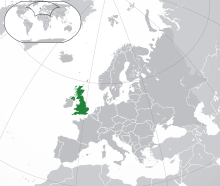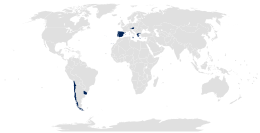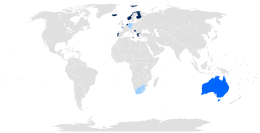Intersex rights in the United Kingdom
| Intersex rights in the United Kingdom | |
|---|---|
 Location of the United Kingdom | |
| Protection of physical integrity and bodily autonomy | No |
| Protection from discrimination | No / Yes (Jersey) |
| Access to same rights as other men and women | No |
| Changing M/F sex classifications | No |
| Third gender or sex classifications | No |
| Marriage | Not all |
| Intersex topics |
|---|
 |
Intersex people in the United Kingdom face significant gaps in legal protections, particularly in protection from non-consensual medical interventions, and protection from discrimination. Actions by intersex civil society organizations aim to eliminate unnecessary medical interventions and harmful practices, promote social acceptance, and equality in line with Council of Europe and United Nations demands.[1][2] Intersex civil society organizations campaign for greater social acceptance, understanding of issues of bodily autonomy, and recognition of the human rights of intersex people.
The island of Jersey has enacted limited protections from discrimination. These do not protect an intersex person from unwanted medical interventions, nor address other issues raised in the Malta declaration.
History

Henry de Bracton's De Legibus et Consuetudinibus Angliae ("On the Laws and Customs of England"), c. 1235,[3] classifies mankind as "male, female, or hermaphrodite",[4] and "A hermaphrodite is classed with male or female according to the predominance of the sexual organs."[5] The 17th-century English jurist and judge Edward Coke (Lord Coke), wrote in his Institutes of the Lawes of England on laws of succession stating, "Every heire is either a male, a female, or an hermaphrodite, that is both male and female. And an hermaphrodite (which is also called Androgynus) shall be heire, either as male or female, according to that kind of sexe which doth prevaile."[6][7] The Institutes are widely held to be a foundation of common law.
The first suggestion to replace the term 'hermaphrodite' with 'intersex', in medicine, came from British physician Cawadias in the 1940s.[8] This suggestion was taken up by other physicians in the UK during the 1960s.[9][10]
Historical intersex figures in the UK include Sir Ewan Forbes (1912-1991), 11th Baronet of Craigievar, Dawn Langley Simmons (1937 or 1922 to 2000), English author and biographer, and Georgina Somerset (née Turtle) (1923-2013), the first openly intersex person in the UK.[11] Prominent present day individuals include "national LGBT treasure" Sarah Graham, writer Iain Morland, Lady Colin Campbell, author of Guide to Being a Modern Lady,[12] Lisa Lee Dark, Welsh opera singer and voice actress, Dee Palmer of Jethro Tull, and Caroline Cossey.
The Androgen Insensitivity Syndrome Support Group (UK) established in 1988, three years after an equivalent Australian group,[13] and some years before the (now-defunct) Intersex Society of North America (ISNA).[14] It has since been joined by Organisation Intersex International UK, Intersex UK[15] and the UK Intersex Association (UKIA).
Intersex UK co-founder Holly Greenberry spoke at the "first United Nations Human Rights Council side event on intersex issues" in March 2014, alongside Mauro Cabral and representatives of Organisation Intersex International Australia and Zwischengeschlecht.[16] She was also quoted in a feature in The Independent stating: “We are at a tipping point ... Most intelligent human beings would be completely surprised and utterly dismayed at the civil inequality and human rights abuses that healthy intersex children and young adults are facing.”[15]
Physical integrity and bodily autonomy

Specialists at the Intersex Clinic at University College London began to publish evidence in 2001 that indicated the harm that can arise as a result of inappropriate interventions, and advised minimising the use of childhood surgical procedures.[17][18][19][20][21][22][23][24][21][25] Data presented in recent years suggests that little has changed in practice. Creighton and others in the UK have found that clitoral surgeries on under-14s have increased since 2006, and "recent publications in the medical literature tend to focus on surgical techniques with no reports on patient experiences".[26]
Parents are frequently considered able to consent to feminizing or masculinizing interventions on their child, and this may be considered standard for the treatment of physical disorders. However this is contested, particularly where interventions seek to address psychosocial concerns. A BMJ editorial in 2015 stated that parents are unduly influenced by medicalized information, may not realize that they are consenting to experimental treatments, and regret may be high.[27] The editorial described current surgical interventions as experimental, stating that clinical confidence in constructing "normal" genital anatomies has not been borne out, and that medically credible pathways other than surgery do not yet exist.[27]
A footnote to a House of Commons report on transgender equality in 2016 suggested that intersex medical interventions were matters of the past,[28] and the country denied such practices in statements to the UN Committee on the Rights of the Child later the same year.[29] However, this is belied by data presented to the UN Committee by intersex civil society organizations later in 2016, including National Health Service Hospital Episode Statistics and clinical publications.[30] In its concluding observations, the Committee expressed concern at "medically unnecessary surgeries and other procedures on intersex children before they are able to provide their informed consent, which often entail irreversible consequences and can cause severe physical and psychological suffering, and the lack of redress and compensation in such cases". It called on the government to "guarantee bodily integrity, autonomy and self-determination to children concerned, and provide families with intersex children with adequate counselling and support", educate professionals, and provide redress.[31]
Protection from discrimination

Intersex people are protected from discrimination in Jersey. Since 1 September 2015, Discrimination (Jersey) Law 2013 includes intersex status within its definition of sex. Sex is one of the prohibited grounds under the act, meaning that discrimination on this basis is prohibited. The act provides that:
"Sex"
(1) Sex is a protected characteristic.
(2) In relation to the protected characteristic –
(a) a reference to a person who has that characteristic is a reference to a man, a woman or a person who has intersex status;
(b) a reference to persons who share the characteristic is a reference to persons who are of the same sex.
(3) In this paragraph, a person has intersex status if the person has physical, chromosomal, hormonal or genetic features that are –
(a) neither wholly male or female;
(b) a combination of male or female; or
(c) neither male nor female— Discrimination (Jersey) Law 2013, Schedule 1, as amended[32]
Identification documents
The United Kingdom does not permit intersex people to change sex classification, except by declaring that they are transgender and following relevant medical protocols including a diagnosis of gender dysphoria.[33]
Right to life
Several intersex variations appear in a list by the UK Human Fertilisation and Embryology Authority of "serious" "genetic conditions" that may be de-selected, including 5 alpha reductase deficiency and androgen insensitivity syndrome, traits evident in elite women athletes and "the world's first openly intersex mayor".[34][35] In 2015, a Council of Europe Issue Paper on Human rights and intersex people stated:
Intersex people’s right to life can be violated in discriminatory “sex selection” and “preimplantation genetic diagnosis, other forms of testing, and selection for particular characteristics”. Such de-selection or selective abortions are incompatible with ethics and human rights standards due to the discrimination perpetrated against intersex people on the basis of their sex characteristics.[1]
Rights advocacy
Notable intersex rights organizations include Intersex UK, OII-UK and the UK Intersex Association. Notable advocates include Sarah Graham.[36] Iain Morland has written extensively on intersex issues, including through personal testimony.[37][38][39] Morland also co-founded Critical Sexology in 2002, a continuing interdisciplinary seminar series on gender and sexuality.[40]
See also
- Intersex UK
- Organisation Intersex International
- Intersex human rights
- LGBT rights in the United Kingdom
- Transgender rights in the United Kingdom
References
- ^ a b Council of Europe; Commissioner for Human Rights (April 2015), Human rights and intersex people, Issue Paper
- ^ UN Committee against Torture; UN Committee on the Rights of the Child; UN Committee on the Rights of People with Disabilities; UN Subcommittee on Prevention of Torture and other Cruel, Inhuman or Degrading Treatment or Punishment; Juan Méndez, Special Rapporteur on torture and other cruel, inhuman, or degrading treatment or punishment; Dainius Pῡras, Special Rapporteur on the right of everyone to the enjoyment of the highest attainable standard of physical and mental health; Dubravka Šimonoviæ, Special Rapporteur on violence against women, its causes and consequences; Marta Santos Pais, Special Representative of the UN Secretary-General on Violence against Children; African Commission on Human and Peoples' Rights; Council of Europe Commissioner for Human Rights; Inter-American Commission on Human Rights (24 October 2016), "Intersex Awareness Day – Wednesday 26 October. End violence and harmful medical practices on intersex children and adults, UN and regional experts urge", Office of the High Commissioner for Human Rights
{{citation}}: CS1 maint: multiple names: authors list (link) - ^ Henry de Bracton. (2009). In Encyclopædia Britannica. Retrieved 17 March 2009, from Encyclopædia Britannica Online
- ^ de Bracton, Henry. On the Laws and Customs of England. Vol. 2 (Thorne ed.). p. 31.
- ^ de Bracton, Henry. On the Laws and Customs of England. Vol. 2 (Thorne ed.). p. 32.
- ^ E Coke, The First Part of the Institutes of the Laws of England, Institutes 8.a. (1st Am. Ed. 1812).
- ^ Greenberg, Julie (1999). "Defining Male and Female: Intersexuality and the Collision Between Law and Biology". Arizona Law Review. 41: 277–278. SSRN 896307.
- ^ Cawadias, A. P. (1943) Hermaphoditus the Human Intersex, London, Heinemann Medical Books Ltd.
- ^ Armstrong, C. N. (1964) "Intersexuality in Man", IN ARMSTRONG, C. N. & MARSHALL, A. J. (Eds.) Intersexuality in Vertebrates Including Man, London, New York, Academic Press Ltd.
- ^ Dewhurst, S. J. & Gordon, R. R. (1969) The Intersexual Disorders, London, Baillière Tindall & Cassell.
- ^ Somerset, G. T. (1992) A Girl Called Georgina – Over the Sex Border, London, The Book Guild.
- ^ ""A very unladylike lady!" by Jenny Johnson, ''Daily Mail'' 10 January 2008". London: Dailymail.co.uk. 9 January 2008. Retrieved 21 August 2009.
- ^ "Androgen Insensitivity Syndrome Support Group (AISSG)". Retrieved 16 May 2016.
- ^ Androgen Insensitivity Syndrome Support Group Australia; Briffa, Anthony (22 January 2003). "Discrimination against People affected by Intersex Conditions: Submission to NSW Government" (PDF). Retrieved 16 May 2016.
- ^ a b Morrison, Sarah (1 December 2013). "Intersex women speak out to protect next generation". The Independent.
- ^ "Intersex side event at the UN Human Rights Council". Organisation Intersex International Australia. Retrieved 29 December 2014.
- ^ Creighton, Sarah M.; Minto, Catherine L.; Steele, Stuart J. (14 July 2001). "Objective cosmetic and anatomical outcomes at adolescence of feminising surgery for ambiguous genitalia done in childhood". The Lancet. 358: 124–125.
- ^ Creighton, Sarah M (2001). "Editorial: Surgery for Intersex". Journal of the Royal Society of Medicine. 94 (5): 218–220.
- ^ Minto, Catherine L.; Creighton, Sarah; Woodhouse, Christopher (1 August 2001). "Long term sexual function in intersex conditions with ambiguous genitalia". Journal of Pediatric and Adolescent Gynecology. 14 (3): 141–142. doi:10.1016/S1083-3188(01)00111-5. ISSN 1083-3188.
- ^ Creighton, Sarah; Minto, Catherine L.; Steele, Stuart J. (1 August 2001). "Cosmetic and anatomical outcomes following feminising childhood surgery for intersex conditions". Journal of Pediatric and Adolescent Gynecology. 14 (3): 142. doi:10.1016/S1083-3188(01)00112-7. ISSN 1083-3188.
- ^ a b Minto, Catherine L; Liao, K.Lih-Mei; Conway, Gerard S; Creighton, Sarah M (July 2003). "Sexual function in women with complete androgen insensitivity syndrome". Fertility and Sterility. 80 (1): 157–164. doi:10.1016/S0015-0282(03)00501-6. ISSN 0015-0282.
- ^ Creighton, Sarah; Minto, Catherine (December 2001). "Managing intersex, Most vaginal surgery in childhood should be deferred". British Medical Journal. 323: 1264–1265.
- ^ Minto, Catherine L; Liao, Lih-Mei; Woodhouse, Christopher R. J.; Ransley, Phillip; Creighton, Sarah M (12 April 2003). "The effect of clitoral surgery on sexual outcome in individuals who have intersex conditions with ambiguous genitalia: a cross-sectional study". The Lancet. 361: 1252–1257.
- ^ Creighton, Sarah; Ransley, Philip; Duffy, Patrick; Wilcox, Duncan; Mushtaq, Imran; Cuckow, Peter; Woodhouse, Christopher; Minto, Catherine; Crouch, Naomi; Stanhope, Richard; Hughes, Ieuan; Dattani, Mehul; Hindmarsh, Peter; Brain, Caroline; Achermann, John; Conway, Gerard; Liao, Lih Mei; Barnicoat, Angela; Perry, Les (July 2003). "Regarding the Consensus Statement on 21-Hydroxylase Deficiency from the Lawson Wilkins Pediatric Endocrine Society and The European Society for Paediatric Endocrinology". The Journal of Clinical Endocrinology & Metabolism. 88 (7): 3454–3456. doi:10.1210/jc.2003-030127. ISSN 0021-972X.
- ^ Crouch, Naomi S.; Minto, Catherine L.; Liao, Lih-Mei; Woodhouse, C R J; Creighton, Sarah M. (2004). "Genital sensation after feminizing genitoplasty for congenital adrenal hyperplasia: a pilot study". BJU International. 93: 135–138. doi:10.1046/j.1464-410X.2004.04572.x.
- ^ Creighton, Sarah M.; Michala, Lina; Mushtaq, Imran; Yaron, Michal (2 January 2014). "Childhood surgery for ambiguous genitalia: glimpses of practice changes or more of the same?". Psychology and Sexuality. 5 (1): 34–43. doi:10.1080/19419899.2013.831214. ISSN 1941-9899. Retrieved 19 July 2015.
- ^ a b Liao, Lih-Mei; Wood, Dan; Creighton, Sarah M (28 September 2015). "Parental choice on normalising cosmetic genital surgery". The BMJ: –5124. doi:10.1136/bmj.h5124. ISSN 1756-1833. Retrieved 30 September 2015.
- ^ United Kingdom; House of Commons; Women and Equalities Committee (January 2016), Transgender Equality (PDF)
- ^ Reid-Smith, Tris (10 June 2016). "Genital mutilation of UK intersex people on the NHS, UN acts". Gay Star News.
- ^ Zwischengeschlecht.org; IntersexUK; OII-UK; The UK Intersex Association (April 2016). Intersex Genital Mutilations Human Rights Violations of Children with Variations of Sex Anatomy: NGO Report to the 5th Periodic Report of the United Kingdom on the Convention on the Rights of the Child (CRC) (PDF). Zurich.
{{cite book}}: CS1 maint: location missing publisher (link) - ^ United Nations; Committee on the Rights of Child (June 2016). "Concluding observations on the fifth periodic report of the United Kingdom of Great Britain and Northern Ireland". Geneva: United Nations.
- ^ "DISCRIMINATION (SEX AND RELATED CHARACTERISTICS) (JERSEY) REGULATIONS 2015". 2015.
- ^ Payton, Naith (23 July 2015). "Comment: Why the UK's gender recognition laws desperately need updating". The Pink Paper.
- ^ Carpenter, Morgan (18 July 2014). "Morgan Carpenter at LGBTI Human Rights in the Commonwealth conference". Glasgow.
{{cite journal}}: Cite journal requires|journal=(help) - ^ Carpenter, Morgan; Organisation Intersex International Australia (30 April 2014). Submission on the Review of Part B of the Ethical Guidelines for the Use of Assisted Reproductive Technology in Clinical Practice and Research, 2007 (Report). Sydney: Organisation Intersex International Australia.
- ^ Graham, Sarah (18 October 2015). "Only two sexes? The barefaced lie that makes intersex people like me invisible". The Independent.
- ^ Morland, Iain (2005). "'The Glans Opens Like a Book': Writing and Reading the Intersexed Body". Continuum: Journal of Media & Culture Studies. 19 (3). Brown University: 335–348. doi:10.1080/103043110500176586. Retrieved 30 November 2014.
- ^ Morland, Iain (June 2011). "Intersex Treatment and the Promise of Trauma". In Fisher, Jill (ed.). Gender and the Science of Difference: Cultural Politics of Contemporary Science and Medicine. New Brunswick, New Jersey: Rutgers University Press. ISBN 978-0-8135-5079-4. Retrieved 30 November 2014.
- ^ Morland, Iain (2012). "The Injured World: Intersex and the Phenomenology of Feeling". differences: A Journal of Feminist Cultural Studies. 23 (2). Brown University: 20–41. doi:10.1215/10407391-1629803. Retrieved 23 October 2014.
- ^ Barker, Meg (2006). "Sexual self-disclosure and outness in academia and the clinic" (PDF). Lesbian and Gay Psychology Review. 7 (3): 292–296. Retrieved 26 December 2014.
Bibliography
- Commissioner for Human Rights; Council of Europe (April 2015), Human rights and intersex people, Issue Paper
- Morland, Iain, ed. (2009). "Intersex and After". GLQ: A Journal of Lesbian and Gay Studies. 15 (2). ISBN 978-0-8223-6705-5.
- Morland, Iain (2005). "'The Glans Opens Like a Book': Writing and Reading the Intersexed Body". Continuum: Journal of Media & Culture Studies. 19 (3). Brown University: 335–348. doi:10.1080/103043110500176586.
- Morland, Iain; Willox, Annabelle, eds. (November 2004). Queer Theory. Palgrave Macmillan. ISBN 9781403916938.
{{cite book}}: Cite has empty unknown parameter:|deadurl=(help) - Simmonds, Margaret (26 September 2012). "Girls/women in inverted commas – facing 'reality' as an XY-female". University of Sussex.
{{cite journal}}: Cite journal requires|journal=(help) - Zwischengeschlecht.org; IntersexUK; OII-UK; The UK Intersex Association (April 2016). Intersex Genital Mutilations Human Rights Violations of Children with Variations of Sex Anatomy: NGO Report to the 5th Periodic Report of the United Kingdom on the Convention on the Rights of the Child (CRC) (PDF). Zurich.
{{cite book}}: CS1 maint: location missing publisher (link) - United Nations; Committee on the Rights of Child (June 2016). "Concluding observations on the fifth periodic report of the United Kingdom of Great Britain and Northern Ireland". Geneva: United Nations.
